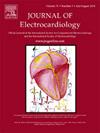早期复极的临床意义:死亡风险的荟萃分析
IF 1.3
4区 医学
Q3 CARDIAC & CARDIOVASCULAR SYSTEMS
引用次数: 0
摘要
背景:心肌复极(ER)历来被认为是良性的,现已成为心血管(CV)事件风险增加的潜在标志,包括心脏骤停(SCA)和心室颤动(VF)。本荟萃分析旨在巩固现有研究的证据,以评估与ER相关的死亡率风险和临床意义。本荟萃分析的目的是评估ER与不同患者人群中各种死亡率结果之间的关系,包括全因死亡率、CV死亡率以及室性心绞痛和SCA的发病率。方法对两大医学数据库(EMBASE和PubMed)自成立至2024年4月进行全面的文献检索。在剔除重复和筛选后,36项研究被纳入最终分析。这些研究包括不同的人群,如普通公众、ICD患者、心肌梗死(MI)/急性冠状动脉综合征(ACS)患者和SCA幸存者。比值比(ORs)使用随机效应模型计算,以解释研究之间的异质性。采用I2统计量量化异质性,采用Eggers回归和漏斗图评估发表偏倚。在最初确定的744篇文章中,有36篇研究符合meta分析的纳入标准,包括一般人群、ICD患者、MI/ ACS患者和SCA幸存者。分析显示,在一般人群中,ER的存在与全因死亡率(OR = 1.2, 95% CI 0.92-1.59, p = 0.18, I2 = 96%)或CV死亡率(OR = 1.3, 95% CI: 0.87-1.9, p = 0.19, I2 = 94%)没有显著相关性。然而,ER与VF和SCA风险增加显著相关(OR = 3.57, 95% CI 1.2-10.7, p = 0.02, I2 = 90%),特别是与ICD、SCA幸存者和MI/ACS患者的VF相关(OR = 4.01, 95% CI 2.5-6.4, p <;0.001, i2 = 76%)。这些发现强调了在风险评估中考虑ER模式的必要性,特别是对于有心肌梗死史或室性心律失常高风险的患者。结论:本荟萃分析证实,虽然内质网模式对全因或CV死亡率没有显著影响,但它们与室性心动过速和SCA风险增加密切相关,特别是在有心肌梗死或ACS病史的患者中。这些发现强调了在临床风险评估中考虑急诊模式的重要性,特别是在高危人群中。本文章由计算机程序翻译,如有差异,请以英文原文为准。
The clinical significance of early repolarization: A meta-analysis of mortality risk
Background
Early repolarization (ER), historically regarded as benign, have emerged as potential markers for increased risk of cardiovascular (CV) events, including sudden cardiac arrest (SCA) and ventricular fibrillation (VF). This meta-analysis seeks to consolidate evidence from available studies to assess the mortality risks and clinical implications associated with ER.
Objectives
The aim of this meta-analysis is to evaluate the association between ER and various mortality outcomes, including all-cause mortality, CV mortality, and the incidence of VF and SCA in different patient populations.
Methods
A comprehensive literature search was performed across two major medical databases (EMBASE and PubMed) from inception to April 2024. After removing duplicates and screening, 36 studies were included in the final analysis. The studies included diverse populations, such as the general public, ICD patients, myocardial infarction (MI)/acute coronary syndrome (ACS) patients, and survivors of SCA. Odds Ratios (ORs) were calculated using a random-effects model to account for heterogeneity among studies. The I2 statistic was employed to quantify heterogeneity, and publication bias was assessed using the Eggers regression and funnel plots.
Results
Out of 744 initially identified articles, 36 studies met the inclusion criteria for the meta-analysis, including general populations, ICD patients, MI/ ACS patients, and survivors of SCA. The analysis revealed that the presence of ER was not significantly associated with all-cause mortality (OR = 1.2, 95% CI 0.92–1.59, p = 0.18, I2 = 96%) or CV mortality (OR = 1.3, 95% CI: 0.87–1.9, P = 0.19, I2 = 94%) in the general population. However, ER was significantly associated with an increased risk of VF and SCA (OR = 3.57, 95% CI 1.2–10.7, p = 0.02, I2 = 90%), and particularly with VF in ICD, SCA survivors and MI/ACS patients (OR = 4.01, 95% CI 2.5–6.4, p < 0.001, I2 = 76%). These findings underscore the need to consider ER patterns in risk assessments, especially for patients with a history of MI or those at high risk for ventricular arrhythmias.
Conclusions
This meta-analysis confirms that while ER patterns do not significantly impact all-cause or CV mortality, they are strongly associated with an increased risk of VF and SCA, particularly in patients with a history of MI or ACS. These findings highlight the importance of considering ER patterns in clinical risk assessments, especially in high-risk populations.
求助全文
通过发布文献求助,成功后即可免费获取论文全文。
去求助
来源期刊

Journal of electrocardiology
医学-心血管系统
CiteScore
2.70
自引率
7.70%
发文量
152
审稿时长
38 days
期刊介绍:
The Journal of Electrocardiology is devoted exclusively to clinical and experimental studies of the electrical activities of the heart. It seeks to contribute significantly to the accuracy of diagnosis and prognosis and the effective treatment, prevention, or delay of heart disease. Editorial contents include electrocardiography, vectorcardiography, arrhythmias, membrane action potential, cardiac pacing, monitoring defibrillation, instrumentation, drug effects, and computer applications.
 求助内容:
求助内容: 应助结果提醒方式:
应助结果提醒方式:


